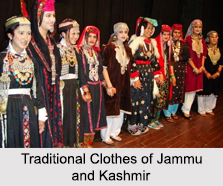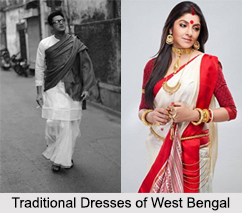The Kanchli, often known as Choli or Angia, is an upper garment worn by married women in most of the Rajasthani communities. Sculptural depictions of a stitched upper garment in western India suggest that its usage began around the beginning of the Christian era. Until then, the upper part of the body was probably covered with a simple, unstitched piece of fabric.
Sculpture, paintings and early Sanskrit literature has plenty of references to a piece of cloth of varied description and width that was simply or artfully tied around the chest. In Hindu tradition, a stitched garment is usually considered impure even today, especially in rural areas, the practice of draping unstitched cloth as an upper-body covering continues specially at marriage ceremonies and religious occasions. Among some tribals of Rajasthan, the upper garment is a contemporary addition to their costume. Until recently, the brides of the Maheshvari community in Rajasthan wore a very simple wedding dress, where the body was wrapped only in a white sari. It was called a kavaljoliya, like a kamal (lotus) flower, and no stitched garments were employed for the marriage ritual.
It is likely that the Saka, Kushana or other tribes from the colder parts of Central Asia were responsible for the introduction of stitched bodices. Initially it would have retained its original features but as it was assimilated into daily wear, the garment was adapted to suit Indian climatic conditions and sartorial tastes.
The Gupta period saw the introduction of the kanchli in western India. It is actually a small bodice with sleeves. In Sanskrit literature this garment is referred to as the kancuka, kan-culika, kurpasa, kurpasaka, choli and angia. It was adopted by women in northern and western India and became a usual feature of their attire, especially in the region that is now Punjab and Rajasthan. Kanchli continued to be worn through the medieval era and is the upper garment of a married woman in Rajasthan and neighbouring states even today.
Among most communities in Rajasthan, a girl alters her upper garment from puthia for a kanchli only when she gets married. This is done after completing the fourth phera, the fourth of the seven circles around the sacred fire in the traditional Hindu wedding ceremony. Although kanchlis are sometimes made from other fabrics like silk, satin and even velvet; cotton is the most preferred fabric for this attire throughout India. Western India with its scorching summers ensures this attire to be the most comfortable one for the married women.
The fascinating choli or kanchli fits firmly on the curve of the womanly figure. It is the finest example of the technical grasp of the moulding of a flat two-dimensional material, the fabric, to the boundaries of a three-dimensional form, the human body. Like the puthia, it is produced employing the geometric sections of cloth. The few scraps of fabric that are left over after the garment is cut are used as trimmings, demonstrating, once again, the thrifty nature of these people. Together with the borders that have no raw edges on the inside give the kanchli further strength and prevent scratch of the tender skin at points of contact. The cutting and construction of the garment supports the womanly figure and gives the body a pleasing silhouette. The garment is designed to enhance-and thus draw attention certain parts of a woman`s body.
The Kanchli usually has a feminine neckline, with three or live points. A high round neckline with a V shape in the centre is also worn. Most kanchli, however, have deep attractive necklines. They are only slightly wider than the modern blouses and are functionally similar. The length of the sleeve varies depending on the ethnic group. Most communities wear a sleeve length, which covers the biceps on the upper arm and, occasionally, a Kanchli can also have elbow or full-length sleeves. The selection of ornaments that accompanies such attire also decides on the design of the garment. For example, a Kanchli with short sleeves does not necessarily mean that the arms are left bare. In many communities, the entire arm is covered with the chuda, bracelets that cover the entire length of the exposed arm, thus proclaiming the wearer`s marital status.
The cords attached to both sides at the back allow for minor changes in body proportions. Tying the strings of the Kanchli loosely or tightly accommodates during periods of pregnancy, lactation or changes in body weight. This makes kanchli extremely comfortable and user friendly. The tie cords, made of wool, cotton, coloured thread or strips of fabric, are very attractive. They can often be long, touching the hem of the ghaghra, with tassels at the ends. The tassels of the attire are decorative, worked with beads, shells, gold and silver threads and mirrors. The cords sway with the movement of the body, adding grace, beauty, motion and, sometimes, even music to the step.
Since the kanchli is revealing, it is usually adorned either with an odhna that drapes across the front and the exposed back or a kurti and odhna, which wealthily covers the torso more completely. At times a small rectangular piece of fabric is stitched to the centre of the hem cover the belly. This is known as apeti and such a garment is a petivali kanchli. The size of the peti indicates the status of the woman. The longer the peti, the more rigid are the concepts of modesty and the higher is the status of that community. In the royal courts, a woman could not enter the women`s quarters in the palace, the zenana, without a petivali kanchli. The tuki is a triangular piece of cloth that covers the upper part of the Kanchli and is especially ornamented. This is usually in a contrasting colour, with gold or silver bands, rickrack or other forms of Rajasthani embroidery. Trimmings on the upper and left parts of the kanchli are more complicated, as these portions are visible, the right side being concealed by the odhna.
Red is the predominant colour of the prints used for the attire kanchli. Other colours are introduced in the form of piping, which is attached as an edging and between the sections of the blouse to make the attire vivid and colour fill. The width and colour of the kanchli varies a great deal, according to its symbolic implications for the community and reflect social status. For example, a fine saffron trim normally represents the marital status of a woman and is included only in the kanchli of a married woman. The saffron fabric is extended at the time of stitching, so it appears as a narrow roll. The piping of the kanchli protects the edges of the blouse from fraying. Often, a second much broader piping is used on the kanchli, which may be in red, green or blue.
Regional variations may be found in the kanchli designs of the same community. When people live together they tend to influence each other`s lifestyles. This is most evident in their everyday attires like kanchli. For instance, the Sindhi Muslim women wear a knee length kanchli, embroidered with mukka work, as their only upper garment. The Meghval, who are a Hindu community and have conventionally lived near the Sindhi Musalman, are influenced by their way of life. This is apparent by their embroidered kanchli or kancbla, which fall below the hipline. However, this Rajasthani attire has a charm of its own that is even used as folk dance costumes as well.





















